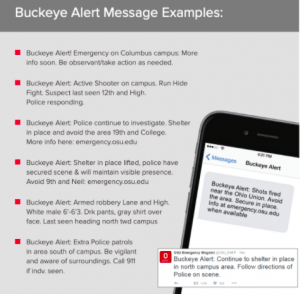Enhance Your Home Fire Safety!
Top 10 Tips to be safe from a fire:
- If a fire breaks out, GET OUT and STAY OUT. Call 911
- Make sure you have enough smoke alarms and that they work
- Know two ways out, especially from bedrooms
- Don’t leave cooking or candles unattended
- Make sure cigarettes are extinguished and don’t smoke in bed
- Keep space heaters 3 feet away from flammable items
- Don’t overload electrical circuits, use a power strip where necessary
- Keep flammable materials at least 3 feet away from water heaters, furnaces and other sources of flames (do not store items in furnace/water heater closets)
- Don’t use a grill on a porch or within 10 feet of a building
- Don’t store gasoline, lighter fluid, etc. inside your house or apartment
Smoke Alarms
Ohio law requires your property manager to provide a working smoke alarm on each level of your home, including the basement. If one of your floors does not have a smoke alarm, or if one of your smoke alarms does not work, contact your property manager immediately.
- Generally, alarms should be placed in the center of a ceiling or, if on a wall, they should be 6 to 12 inches below the ceiling.
- For maximum warning, smoke alarms should be installed on every level of the home, outside sleeping areas, and inside bedrooms.
- In addition to the smoke alarms provided by your property manager, you can purchase additional alarms online or at your local hardware store.
- Off-Campus and Commuter Student Services offers free smoke alarm batteries, go to offcampus.osu.edu, https://offcampus.osu.edu/resources/safety/, for more information!
Test Your Smoke Alarm Monthly
To test:
- Press and hold the test button
- Wait for the smoke alarm to beep
- If the smoke alarm does not beep, replace the batteries
- If you re-test the alarm with new batteries and it still does not beep, replace the smoke alarm
Signs you need a new smoke alarm or battery:
- The smoke alarm makes short beeps regularly, or
- The smoke alarm is more than 10 years old and has exceeded its lifespan.
- You can find the manufacture date on the back of the alarm
No Combustible Materials Stored Indoors or Near Heating Appliances
Your furnace and water heater are heat sources that can cause a fire by igniting nearby flammable or combustible materials. If your furnace and water heater are in your basement, keep flammable materials at least 3 feet away. If your furnace and water heater are in a closet, keep the entire closet clear of any items. Do not use your furnace and water heater closet as storage; it is a serious fire hazard.
Fire Extinguisher on Each Floor
A fire extinguisher can confine and possibly put out a small fire, resulting in saved lives and property. If you purchase a fire extinguisher, select an “ABC” extinguisher. An ABC fire extinguisher is a multi-purpose fire extinguisher that can be used on:
- A: Ordinary combustible materials, such as cloth, wood, rubber, paper, and many plastics
- B: Flammable liquids, such as grease, gasoline, oil, and oil-based paints
- C: Electrical appliances
When to Use a Fire Extinguisher
Use a fire extinguisher only if:
- All residents have evacuated the building and the fire department has been called
- The room is not filled with smoke
- You have an unblocked exit to escape
- The fire is confined to a small area and is not growing
- You feel comfortable using the fire extinguisher
How to use a Fire Extinguisher
Remember the word “PASS” when you use a fire extinguisher:
- Pull the pin and hold the extinguisher with the nozzle pointed toward the fire
- Aim low and point the nozzle at the base of the fire
- Squeeze the lever slowly and evenly
- Sweep the nozzle from side to side
Emergency Escape Ladders
Your ability to escape a fire depends on advance warning from smoke alarms and advance planning. You and everyone else you live with should have an escape plan in the event of a fire. If a fire starts, you only have a few minutes to escape before poisonous smoke and flames engulf your home. A quick escape requires a plan. Create an escape plan that includes the following:
- Two exits for every room
- An outside meeting place (i.e. neighbor’s house, a light post, mailbox, or stop sign) a safe distance in front of your home where everyone can meet after they’ve escaped.
If your home has two floors, everyone in an upstairs bedroom must be able to escape from second-floor rooms. Escape ladders can be placed in or near windows to provide an additional escape route if your primary exit is blocked by fire. To learn more about safely escaping a home fire, participate in the Fire Safety Training Event on campus.




